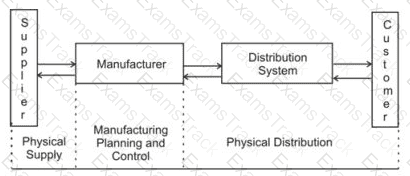Companies are more likely to consider the consequences of their product design decisions when they view the reverse supply chain as an extension of the:
The main benefit of a mass customization product design strategy is to:
Which of the following situations is an example of inventory being held as a way to balance supply and demand?
Which of the following results can be expected from sharing a common understanding of demand and consumption patterns among supply chain participants?
The question below is based on the following flowchart:

Which of the following phrases most accurately describes the complete flow of demand information?
Which of the following scenarios represents a correct application of the Supply-Chain Operations Reference-model (SCOR)?
Reverse supply chain activity typically peaks nearest the beginning of which of the following stages of the product life cycle?
Maintaining a long-term collaborative relationship with a trading partner requires:
A main benefit of using customer relationship management (CRM) is:
Which of the following is the most important result when a company implements customer relationship management?
Which of the following types of information would be an appropriate basis for a qualitative forecast?
The value that logistics provides within the supply chain can best be summarized as:
Which of the following factors typically is the most significant impediment to implementing collaborative commerce?
The purpose of continuous improvement in the supply chain is to:
Medium-term demand management projections are used primarily to:
|
PDF + Testing Engine
|
|---|
|
$49.5 |
|
Testing Engine
|
|---|
|
$37.5 |
|
PDF (Q&A)
|
|---|
|
$31.5 |
APICS Free Exams |
|---|

|